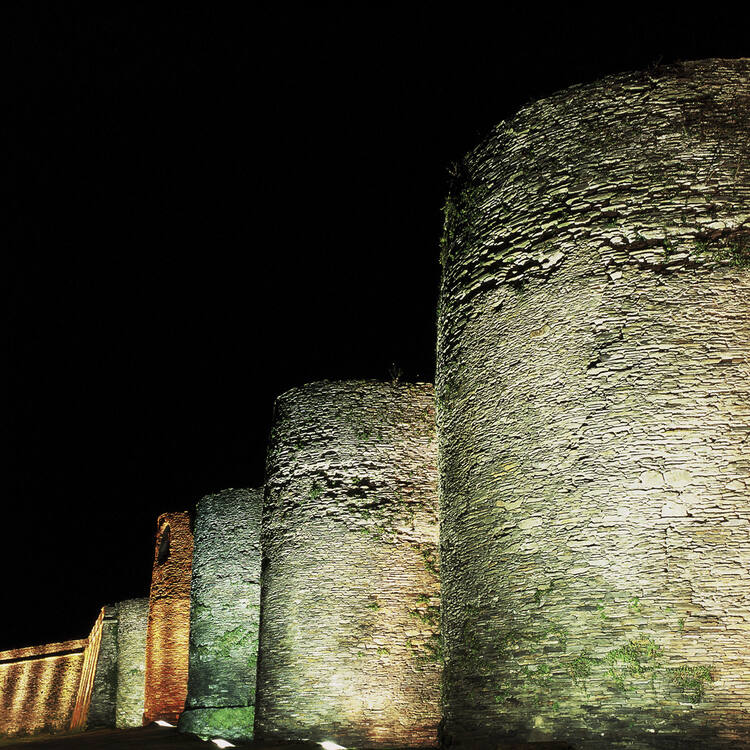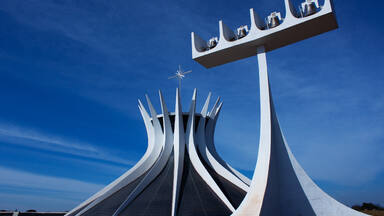Roman Walls of Lugo
Roman Walls of Lugo
The walls of Lugo were built in the later part of the 3rd century to defend the Roman town of Lucus. The entire circuit survives intact and is the finest example of late Roman fortifications in western Europe.
Description is available under license CC-BY-SA IGO 3.0
Remparts romains de Lugo
Les remparts de Lugo furent construits à la fin du IIe siècle pour défendre la ville romaine de Lucus. Tout le circuit demeure intact et constitue le plus bel exemple de fortifications romaines tardives en Europe occidentale.
Description is available under license CC-BY-SA IGO 3.0
أسوار لوغو الرومانية
شُيّدت أسوار لوغو الرومانيّة نهاية القرن الثاني للدفاع عن مدينة لوكوس الرومانيّة. ولا يزال تتابع السور على حاله ويُشكّل أبرز مثالٍ عن حصون رومانيّة شُيّدت لاحقاً في أوروبا الغربيّة.
source: UNESCO/CPE
Description is available under license CC-BY-SA IGO 3.0
卢戈的罗马城墙
卢戈城墙修建于公元3世纪末期,用于保卫罗马城镇卢戈斯。整个圆形城墙至今保存完好,是西欧罗马帝国晚期城堡的最完美样例之一。
source: UNESCO/CPE
Description is available under license CC-BY-SA IGO 3.0
Древнеримские стены в городе Луго
Эти крепостные стены были построены в конце III в. для защиты древнеримского города Лукус. Они сохранились неповрежденными по всему периметру, представляя собой превосходный пример древнеримских укреплений в Западной Европе.
source: UNESCO/CPE
Description is available under license CC-BY-SA IGO 3.0
Muralla romana de Lugo
La muralla de Lugo fue construida a finales de siglo II para defender la ciudad romana de Lucus. Su perímetro se ha conservado intacto en su totalidad y constituye el más bello arquetipo de fortificación romana tardía de toda Europa Occidental.
source: UNESCO/CPE
Description is available under license CC-BY-SA IGO 3.0
ルーゴのローマの城壁群
スペイン北西部、ビスケー湾に面するルーゴ州の州都。この城壁は2世紀後半、ケルト人の集落をローマが占領し、重要な軍事拠点として建設されたもので、地名はルークス・アウグスティと改称された。この堅塁はその後の相次ぐ攻撃や8世紀のムーア人の侵入にも耐えている。そのため保存上や夷が良く、一周2131mにおよぶ城壁全体が損傷なく残っており、西ヨーロッパで見られるローマ帝国時代の城砦建築技術を今に伝える貴重な例証になっている。source: NFUAJ
Romeinse muren van Lugo
De muren van Lugo werden in het laatste deel van de 3e eeuw gebouwd om de Romeinse stad Lucus Augusti te verdedigen. Het hele bouwwerk is intact gebleven en vormt het mooiste voorbeeld van laat Romeinse vestingwerken in West-Europa. De muren hebben een Romeinse oorsprong, maar maakten ook de problematische middeleeuwen en vernieuwende 19e eeuw mee. Hierdoor verenigt deze monumentale constructie van meer dan 2 kilometer lang de bewijzen en facetten van de evolutie van een stad; van het oorspronkelijke Lucus Augusti naar de stad Lugo (zelf overigens ook een historisch en artistiek geheel).
Source: unesco.nl
Outstanding Universal Value
Brief synthesis
Roman Walls of Lugo, a city in the Autonomous Region of Galicia in north-western Spain, are an exceptional architectural, archaeological and constructive legacy of Roman engineering, dating from the 3rd and 4th centuries AD. The Walls are built of internal and external stone facings of slate with some granite, with a core filling of a conglomerate of slate slabs and worked stone pieces from Roman buildings, interlocked with lime mortar.
Their total length of 2117 m in the shape of an oblong rectangle occupies an area of 1.68 ha. Their height varies between 8 and 10 m, with a width of 4.2 m, reaching 7 m in some specific points. The walls still contain 85 external towers, 10 gates (five of which are original and five that were opened in modern times), four staircases and two ramps providing access to the walkway along the top of the walls, one of which is internal and the other external. Each tower contained access stairs leading from the intervallum to the wall walk of town wall, of which a total of 21 have been discovered to date.
The defences of Lugo are the most complete and best preserved example of Roman military architecture in the Western Roman Empire.
Despite the renovation work carried out, the walls conserve their original layout and the construction features associated with their defensive purpose, with walls, battlements, towers, fortifications, both modern and original gates and stairways, and a moat.
Since they were built, the walls have defined the layout and growth of the city, which was declared a Historical-Artistic Ensemble in 1973, forming a part of it and becoming an emblematic structure that can be freely accessed to walk along. The local inhabitants and visitors alike have used them as an area for enjoyment and as a part of urban life for centuries.
Criterion (iv): The Roman walls of Lugo are the finest surviving example of late Roman military fortifications.
Integrity
Roman Walls of Lugo visibly conserve their original layout and more than half of their original towers and defensive structures, gates, stairways and other elements, together with a large number of archaeological remains from the period, which help to situate the structure within its historical context, and bear witness to its creation and evolution. The property boundaries include the whole fortifications, while the intramural and extramural areas are included in a buffer zone.
Very few monumental complexes can offer the same historical authenticity and archaeological integrity, both in terms of their size and their inclusion within an urban setting, and their continued use, as part of a wider and increasingly well-known context offering a large number of archaeological remains associated with the monument. Its originality was confirmed by the findings that have been made and the studies carried out on its full layout and structure, on the moat, or on the recovery of its original gateways and stairways, all solid proof of its Roman origins (from between the third and fourth centuries AD).
The use of local materials such as slate, granite and other stones that were re-used in the construction process gives the late imperial walls an original appearance, further enhanced by the fact that their perimeter and upper walkway are completely intact.
Pressures affecting the Roman Walls include the effects of the use of transport infrastructure, water and relative humidity but these are all minor and under control.
Authenticity
The authenticity of the Roman Walls of Lugo lies in the way that they have survived intact for eighteen centuries. There have been many interventions over that long period to individual parts of the walls for practical and aesthetic purposes, which mean that they do not survive in their precise original form, and so, using a restricted interpretation, they might be considered to be lacking in some measure of authenticity. However, as an ensemble their authenticity is impeccable.
Protection and management requirements
The legal framework that controls interventions carried out on the monument has its origins in the Spanish Constitution, in the Statute of Autonomy of Galicia, Organic Law 1/1981 of 6 April, and in Royal Decree 2434/1982 of 24 July on the transfer of functions and services from the State Authorities to the Autonomous Region of Galicia in cultural matters. Roman Walls of Lugo is considered as an Asset of Cultural Interest by the Royal Order of April 16, 1921, giving it the highest legal protection of their cultural values.
Any intervention involving the Walls or their surrounding area must comply with the specific regulations on the protection of cultural heritage at national level, as set out in Law 16/1985 on Spanish Historical Heritage, and regional regulations set out in Law 8/1995 on the Cultural Heritage of Galicia.
This regulatory framework involves the collaboration of three public authorities who are responsible for protecting the monument: the central State Authorities, the Regional Authorities of the Xunta de Galicia, and the local authorities of Lugo City Council. This collaboration between the different authorities is the basis for the direct management of the monument, carried out by the Xunta de Galicia as the owner and responsible authority for its care within the autonomous region.
All restoration and maintenance work on the Roman Walls is carried out in strict compliance with the directives of the Advance Integral Plan for the Conservation and Restoration of the Walls of Lugo.
Lugo City Council is responsible for managing actions carried out on the Walls in accordance with the stipulations of the Special Plan for the Protection, Rehabilitation and Reformation of the Walled Area of the City of Lugo and its Area of Influence. The municipality has begun a series of interventions aimed at preserving the monument, which essentially consist of protecting it from traffic and pollution by turning the road that runs around the walls into a pedestrian walkway, and by creating an interior pedestrian walkway that relieves the adjacent structures with a series of green spaces along their whole extent. All of these plans focus on a process of renovation, rehabilitation and enhancement of Lugo’s cultural heritage, represented in a building that has been specially built for this purpose, the Visitors’ Centre for the Walls.
Notes
-
Following a survey of ownership carried out in the late 1960s, ownership of the totality of the walls was vested in 1973 in the Spanish State, through the Ministry of Education and Science. It was transferred to the Xunta de Galicia by Royal Decree in 1994.
The Spanish Constitution reserves certain rights in relation to the heritage to the central government. However, these are delegated to the competent agencies in the Autonomous Communities, in this case the Xunta de Galicia. For the Lugo walls the Xunta is in the position of both owner and competent agency. Under the Galician Heritage Law the Xunta is required to cooperate with the municipal authorities in ensuring the protection and conservation of listed monuments, and certain functions are delegated down to them. The Xunta operates through its General Directorate of Cultural Heritage (Dirección General de Patrimonio Cultural), based in Santiago de Compostela.
The Master Plan for the Conservation and Restoration of the Roman Walls of Lugo (1992) covered proposals for actions to be taken in respect of research and techniques of restoration. This was followed in 1997 by the Special Plan for the Protection and Internal Reform of the Fortified Enceinte of the Town of Lugo, which is concerned principally with the urban environment of the historic town. However, it has a direct impact on the protection afforded to the walls, in terms of traffic planning, the creation of open spaces, and regulation of building heights. Another planning instrument which affects the walls is the Special Plan for the Protection of the Miño [river], approved by the municipality at the beginning of 1998.
There is at the present time no management plan sensu stricto for the walls in operation in Lugo: work is continuing on the basis of the 1992 plan. Nor is there a technical unit specifically responsible for the conservation and restoration of the walls. It is against this background that serious consideration is being given to the creation of an independent foundation, under royal patronage and with representatives from government, academic, voluntary, and business institutions, to work with the General Directorate of Cultural Heritage of Galicia. The work plan of this body would include the development and implementation of integrated conservation, restoration, and maintenance programmes.

 View photos from OUR PLACE the World Heritage collection
View photos from OUR PLACE the World Heritage collection
